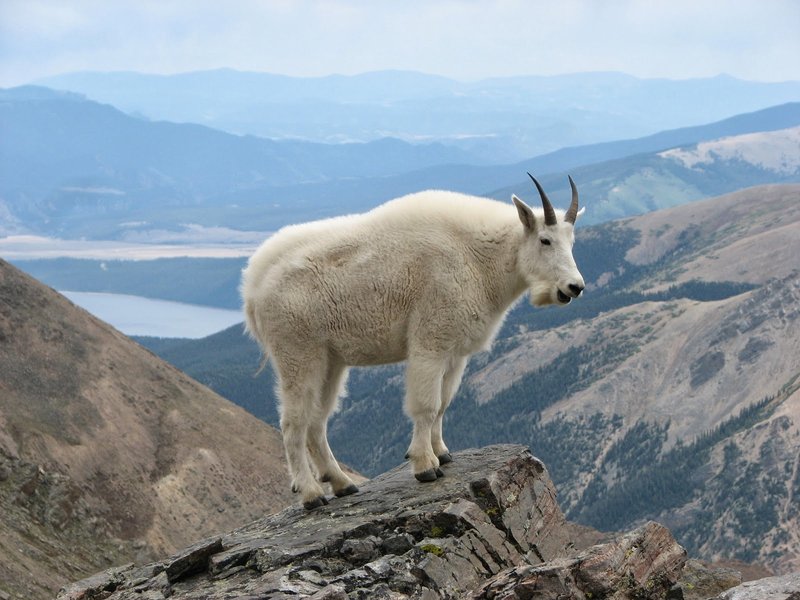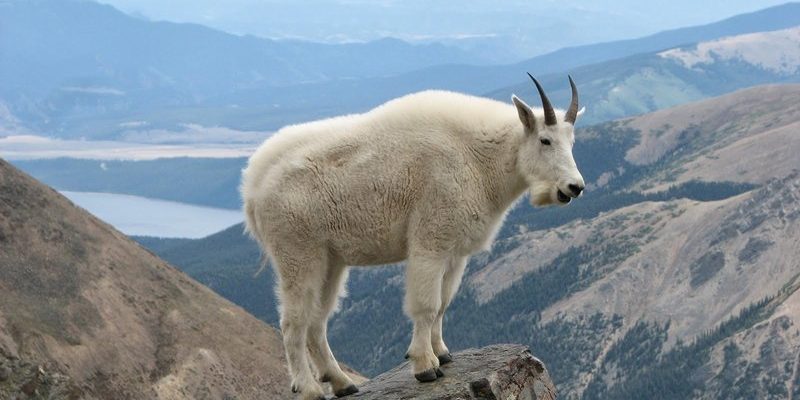
When you think of mountain goats, picture a creature that thrives in some of the harshest, most rugged terrains. With their impressive climbing skills and striking appearance, these animals are fascinating to many. Mountain goats are not true goats; they belong to the family Bovidae and are actually more closely related to antelopes. These remarkable animals can be found in North America’s steep, rocky mountains, showing just how adaptable life can be.
You might be wondering what makes the mountain goat so special. Their sturdy hooves, thick fur, and agile nature allow them to navigate steep cliffs and rocky ledges with grace. They often appear to defy gravity, standing on precarious ledges as they munch on grasses and shrubs. It’s a testament to their incredible adaptations, and there’s so much to learn about these hardy creatures.
Physical Characteristics
Mountain goats are easily recognizable thanks to their distinctive features. Adult males, also called billies, can weigh between 150 and 300 pounds, while females, known as nannies, are generally smaller, weighing around 70 to 150 pounds. One of the most striking aspects of their appearance is their thick, white fur, which helps insulate them against the cold mountain weather. In fact, their fur is so dense that it can trap air to provide additional warmth.
But it doesn’t stop there! They have large, curved horns that can grow up to 12 inches long on males and are typically smaller on females. These horns are not just for show; they serve as valuable tools for sparring and defending against predators. Interestingly, mountain goats also have a unique adaptation in their hooves—they feature a hard outer shell coupled with a softer inner pad. This allows them to grip rocky surfaces effectively, making them natural-born climbers.
Habitat and Distribution
Mountain goats call the steep, alpine regions of North America home. You’ll find them primarily in the Rocky Mountains, covering areas in the United States and Canada. Their preferred habitats are those rugged terrains that rise above the tree line, where they can be found on rocky slopes, cliffs, and crags. These areas not only provide safety from predators but also access to their favorite food sources, such as grasses, herbs, and shrubs.
What’s fascinating is that mountain goats are incredibly adaptable to their environment. They can survive in altitudes ranging from 4,000 to over 13,000 feet, often encountering extreme temperatures and harsh weather conditions. Their thick fur coat plays a vital role in this survival, but they also rely on other strategies, like seeking out wind-sheltered areas during storms. So, while they may seem like they live in a daunting environment, mountain goats have evolved to thrive in what many would consider an inhospitable habitat.
Diet and Feeding Habits
Mountain goats are herbivores, primarily feeding on grasses, leaves, and shrubs. But their diet isn’t as simple as it sounds! They are known to be opportunistic eaters and will consume a variety of vegetation depending on what is available in their rocky habitat. During the warmer months, when vegetation is plentiful, they can be seen grazing on alpine meadows. In winter, their diet shifts to more fibrous materials, like conifer needles and bark, which are tougher but provide essential nutrients.
Interestingly, mountain goats have developed a unique behavior around feeding. They often engage in a behavior known as “browsing,” where they’ll carefully select plants and leaves to consume. This selective feeding helps ensure they get the best nutrition possible, even in their challenging environment. And while you might think that finding food would be tough in such rocky terrain, they have a keen eye for spotting edible plants, showcasing their impressive survival skills.
Social Structure
Mountain goats are social animals that typically live in groups. These groups, also known as herds, can vary in size from just a few individuals to over thirty, depending on the season and availability of resources. Nannies and their kids often form the core of these herds, while billies tend to be more solitary or form their own groups, especially outside of mating season.
Social interactions among mountain goats are interesting. Within their herds, you may observe playful behaviors, grooming, and even sparring among young males as they establish dominance. This social structure helps them stay safe from predators like big cats and wolves. When threatened, they’ll rely on their ability to escape quickly and find refuge on sheer cliffs, where agility and teamwork really come into play.
Reproduction and Life Cycle
Mountain goat reproduction is quite fascinating. The mating season occurs in late autumn, when males spar for the right to mate with females. After a gestation period of about six months, females give birth to one or two kids during the late spring. These kids are incredibly vulnerable at birth but are able to stand and walk within just a few hours. This quick development is crucial for their survival, especially in steep, rocky environments.
As they grow, kids start to become more independent and will remain with their mothers until they are about a year old. During this time, they learn vital survival skills, such as foraging for food and navigating the dramatic terrain. By the time they reach adulthood, they’ll have a solid grasp of the challenges and behaviors required to thrive in their mountain home.
Threats and Conservation Status
While mountain goats are well adapted to their rugged environments, they still face threats. One of the biggest challenges for these animals is climate change, which can alter their habitat and food supply. Increased temperatures and unpredictable weather patterns can lead to habitat loss, leaving mountain goats in a difficult position to find food and shelter.
Additionally, predation by large carnivores can impact local populations, especially in areas where their habitat overlaps. However, human activities also pose significant risks. Development, tourism, and road construction can encroach on their natural habitats and disrupt their migratory patterns. Conservation efforts are essential to help protect these majestic animals and ensure their survival into the future.
Interesting Facts
| Scientific Name: | Oreamnos americanus |
| Weight: | 70 to 300 pounds |
| Height: | 3.5 to 4.5 feet at the shoulder |
| Lifespan: | 12 to 15 years in the wild |
| Habitat: | Rocky mountain ranges |
| Diet: | Grasses, shrubs, and herbs |
The mountain goat truly embodies resilience and adaptability. From their striking appearance to their remarkable climbing abilities, these animals are a testament to the wonders of nature. They remind us of the beauty found in diverse ecosystems and the importance of conserving habitats for future generations. The next time you think about mountain goats, imagine them standing majestically on a rocky ledge, a perfect blend of strength and grace in an untamed world.
FAQ
What is the difference between a mountain goat and a regular goat?
Mountain goats are not true goats; they belong to a different genus known as Oreamnos. Unlike domestic goats, which have been bred for various human needs, mountain goats have adapted specifically to life in rugged, mountainous environments. Their physical adaptations, like specialized hooves and thick fur, set them apart, allowing them to thrive where other goats cannot.
How fast can mountain goats run?
Mountain goats are surprisingly agile. They can run at speeds of up to 30 miles per hour on flat terrain. However, what’s even more impressive is their climbing ability. They can navigate sheer cliffs and rocky paths with ease, often scrambling up steep inclines that would be nearly impossible for most other animals.
Can mountain goats be domesticated?
Mountain goats are not domesticated animals, as they have evolved to thrive in the wild. Unlike domestic goats, mountain goats do not exhibit the same social behavior that would make them suitable for domestication. They are wild animals with specific habitat and dietary needs that make them unsuitable as pets or farm animals.
What predators do mountain goats face?
Although mountain goats are well adapted to evade many predators, they do face threats from animals like mountain lions, wolves, and bears. In some areas, golden eagles may also target young kids. Mountain goats rely heavily on their agility and the steep terrain of their habitat to escape from these potential threats.
How long do mountain goats live in the wild?
In the wild, mountain goats typically have a lifespan of about 12 to 15 years. However, factors such as predation, habitat loss, and food availability can impact their longevity. In protected environments like national parks, they might live even longer due to reduced threats from human activity.
Do mountain goats have any natural threats besides predators?
Yes, mountain goats face various natural threats beyond predation. Climate change significantly affects their habitat and food sources. As temperatures rise and weather patterns shift, the availability of vegetation and suitable habitats can be compromised. Additionally, natural disasters like avalanches or landslides can also pose risks to their populations.
Are mountain goats social animals?
Yes, mountain goats are social creatures that often live in herds. These herds usually consist of females and their young, while males may form separate groups or live alone outside of the mating season. Their social structures help provide protection against predators and ensure that they can find food more effectively.
What do mountain goats do in winter?
In winter, mountain goats adapt to the colder temperatures and reduced food availability by seeking out lower elevations where they can find food more easily. They also rely on their thick fur and fat reserves to stay warm. During harsh conditions, they may stay in sheltered areas to conserve energy and protect themselves from severe weather.
How can we help protect mountain goats?
Helping protect mountain goats involves supporting conservation efforts aimed at preserving their natural habitats. Staying informed about local ecosystems, respecting wildlife regulations while visiting their habitats, and supporting organizations that work to protect these animals can all contribute to their conservation. Habitat preservation is key to ensuring mountain goats and many other species continue to thrive.
Do mountain goats migrate?
Mountain goats do not migrate in the traditional sense, but they may move between higher and lower elevations depending on the season. During warmer months, they tend to graze in alpine meadows, while in winter, they move toward lower elevations to find food and shelter. This movement helps them adapt to seasonal changes and survive in their challenging environment.
Are mountain goats endangered?
Mountain goats are not currently classified as endangered, although their populations can be affected by habitat loss, climate change, and human activity. The local status of mountain goat populations can vary depending on specific regions and environmental conditions, making conservation efforts essential for maintaining healthy populations.
What are some key adaptations of the mountain goat?
Mountain goats showcase a range of adaptations that help them thrive in their rocky habitats. Their specialized hooves provide excellent grip on steep, uneven surfaces, while their thick fur offers insulation against harsh weather. Additionally, mountain goats have excellent eyesight that helps them detect predators and navigate their rugged environment successfully.

